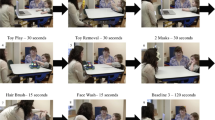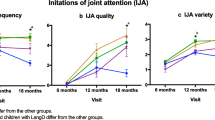Abstract
Infants at risk for autism spectrum disorders (ASD) may have difficulty integrating smiles into initiating joint attention (IJA) bids. A specific IJA pattern, anticipatory smiling, may communicate preexisting positive affect when an infant smiles at an object and then turns the smile toward the social partner. We compared the development of anticipatory smiling at 8, 10, and 12 months in infant siblings of children with ASD (high-risk siblings) and without ASD (low-risk siblings). High-risk siblings produced less anticipatory smiling than low-risk siblings, suggesting early differences in communicating preexisting positive affect. While early anticipatory smiling distinguished the risk groups, IJA not accompanied by smiling best predicted later severity of ASD-related behavioral characteristics among high-risk siblings. High-risk infants appear to show lower levels of motivation to share positive affect with others. However, facility with initiating joint attention in the absence of a clear index of positive affective motivation appears to be central to the prediction of ASD symptoms.




Similar content being viewed by others
References
Adamson, L. B., Bakeman, R., Deckner, D. F., & Romski, M. (2009). Joint engagement and the emergence of language in children with autism and Down syndrome. Journal of Autism and Developmental Disorders, 39(1), 84–96. doi:10.1007/s10803-008-0601-7.
American Psychiatric Association. (2000). Diagnostic and statistical manual of mental disorders (4, text rev ed.). Washington, DC: Author.
Bakeman, R., & Adamson, L. B. (1984). Coordinating attention to people and objects in mother–infant and peer–infant interaction. Child Development, 55(4), 1278–1289. doi:10.2307/1129997.
Bedford, R., Elsabbagh, M., Gliga, T., Pickles, A., Senju, A., Charman, T., et al. (2012). Precursors to social and communication difficulties in infants at-risk for autism: Gaze following and attentional engagement. Journal of Autism and Developmental Disorders, 42(10), 2208–2218. doi:10.1007/s10803-012-1450-y.
Berument, S., Rutter, M., Lord, C., Pickles, A., & Bailey, A. (1999). Autism screening questionnaire: Diagnostic validity. The British Journal of Psychiatry, 175, 444–451. doi:10.1192/bjp.175.5.444.
Bloom, L., Beckwith, R., & Capatides, J. B. (1988). Developments in the expression of affect. Infant Behavior and Development, 11(2), 169–186. doi:10.1016/S0163-6383(88)80004-3.
Bloom, L., & Capatides, J. B. (1987). Expression of affect and the emergence of language. Child Development, 58(6), 1513–1522. doi:10.2307/1130691.
Cassel, T. D., Messinger, D. S., Ibanez, L. V., Haltigan, J. D., Acosta, S. I., & Buchman, A. C. (2007). Early social and emotional communication in the infant siblings of children with autism spectrum disorders: An examination of the broad phenotype. Journal of Autism and Developmental Disorders, 37(1), 122–132. doi:10.1007/s10803-006-0337-1.
Damiano, C. R., Nahmias, A., Hogan-Brown, A. L., & Stone, W. L. (2013). What do repetitive and stereotyped movements mean for infant siblings of children with autism spectrum disorders? Journal of Autism and Developmental Disorders, 43(6), 1326–1335. doi:10.1007/s10803-012-1681-y.
Dawson, G., Hill, D., Spencer, A., Galpert, L., & Watson, L. (1990). Affective exchanges between young autistic children and their mothers. Journal of Abnormal Child Psychology, 18(3), 335–345. doi:10.1007/BF00916569.
Dawson, G., Toth, K., Abbott, R., Osterling, J., Munson, J., Estes, A., et al. (2004). Early social attention impairments in autism: Social orienting, joint attention, and attention to distress. Developmental Psychology, 40(2), 271–283. doi:10.1037/0012-1649.40.2.271.
Ekman, P., & Friesen, W. V. (1978). Facial action coding system. Palo Alto, CA: Consulting Psychologist Press.
Georgiades, S., Szatmari, P., Zwaigenbaum, L., Bryson, S., Brian, J., Roberts, W., et al. (2013). A prospective study of autistic-like traits in unaffected siblings of probands with autism spectrum disorder. JAMA Psychiatry, 70(1), 42–48. doi:10.1001/2013.jamapsychiatry.1.
Gerdts, J., & Bernier, R. (2011). The broader autism phenotype and its implications on the etiology and treatment of autism spectrum disorders. Autism Research and Treatment, 2011. doi: 10.1155/2011/545901.
Goldberg, W. A., Jarvis, K. L., Osann, K., Laulhere, T. M., Straub, C., Thomas, E., et al. (2005). Brief report: Early social communication behaviors in the younger siblings of children with autism. Journal of Autism and Developmental Disorders, 35(5), 657–664. doi:10.1007/s10803-005-0009-6.
Gotham, K., Pickles, A., & Lord, C. (2009). Standardizing ADOS scores for a measure of severity in autism spectrum disorders. Journal of Autism and Developmental Disorders, 39(5), 693–705. doi:10.1007/s10803-008-0674-3.
Ibañez, L. V., Grantz, C. J., & Messinger, D. S. (2012). The development of referential communication and autism symptomatology in high-risk infants. Infancy,. doi:10.1111/j.1532-7078.2012.00142.x.
Jones, S. S., Collins, K., & Hong, H. (1991). An audience effect on smile production in 10-month-old infants. Psychological Science, 2(1), 45–49. doi:10.1111/j.1467-9280.1991.tb00095.x.
Jones, S. S., & Hong, H. (2001). Onset of voluntary communication: Smiling looks to mother. Infancy, 2(3), 353–370. doi:10.1207/S15327078IN0203_4.
Jones, S. S., & Hong, H. (2005). How some infant smiles get made. Infant Behavior & Development, 28(2), 194–205. doi:10.1016/j.infbeh.2005.02.003.
Jones, S. S., & Raag, T. (1989). Smile production in older infants: The importance of a social recipient for the facial signal. Child Development, 60(4), 811–818. doi:10.2307/1131021.
Joseph, R. M., & Tager-Flusberg, H. (1997). An investigation of attention and affect in children with autism and Down syndrome. Journal of Autism and Developmental Disorders, 27(4), 385–396. doi:10.1023/A:1025853321118.
Kasari, C., Sigman, M., Mundy, P., & Yirmiya, N. (1990). Affective sharing in the context of joint attention interactions of normal, autistic, and mentally retarded children. Journal of Autism and Developmental Disorders, 20(1), 87–100. doi:10.1007/BF02206859.
Landa, R., & Garrett-Mayer, E. (2006). Development in infants with autism spectrum disorders: A prospective study. Journal of Child Psychology and Psychiatry, 47(6), 629–638. doi:10.1111/j.1469-7610.2006.01531.x.
Lord, C., Risi, S., Lambrecht, L., Cook, E. H., Leventhal, B. L., DiLavore, P. C., et al. (2000). The autism diagnostic observation schedule-generic: A standard measure of social and communication deficits associated with the spectrum of autism. Journal of Autism and Developmental Disorders, 30, 205–223.
Messinger, D. S., & Fogel, A. (1998). Give and take: The development of conventional infant gestures. Merrill-Palmer Quarterly: Journal of Developmental Psychology, 44(4), 566–590.
Mullen, E. (1995). Mullen scales of early learning. Circle Pines, MN: American Guidance Service.
Mundy, P., Block, J., Delgado, C., Pomares, Y., Van Hecke, A., & Parlade, M. (2007). Individual differences and the development of joint attention in infancy. Child Development, 78(3), 938–954. doi:10.1111/j.1467-8624.2007.01042.x.
Mundy, P., Delgado, C., Block, J., Venezia, M., Hogan, A., & Siebert, J. (2003). A manual for the abridged Early Social Communication Scales (ESCS). Coral Gables, FL: University of Miami, Department of Psychology.
Mundy, P., Sigman, M., & Kasari, C. (1990). A longitudinal study of joint attention and language development in autistic children. Journal of Autism and Developmental Disorders, 20(1), 115–128. doi:10.1007/BF02206861.
Mundy, P., Sigman, M. D., Ungerer, J., & Sherman, T. (1986). Defining the social deficits of autism: The contribution of non-verbal communication measures. Child Psychology & Psychiatry & Allied Disciplines, 27(5), 657–669. doi:10.1111/j.1469-7610.1986.tb00190.x.
Mundy, P., & Vaughan, A. (2001). Joint attention and its role in the diagnostic assessment of children with autism. Assessment for Effective Intervention, 27(1–2), 57–60. doi:10.1177/073724770202700108.
Nichols, C. M., Ibañez, L. V., Foss-Feig, J. H., & Stone, W. L. (2013). Social smiling and its components in high-risk infant siblings without later asd symptomatology. Journal of Autism and Developmental Disorders,. doi:10.1007/s10803-013-1944-2.
Ozonoff, S., Losif, A., Baguio, F., Cook, I. C., Hill, M., Hutman, T., et al. (2010). A prospective study of the emergence of early behavioral signs of autism. Journal of the American Academy of Child and Adolescent Psychiatry, 49(3), 256–266. doi:10.1097/00004583-201003000-00009.
Ozonoff, S., Young, G. S., Carter, A., Messinger, D., Yirmiya, N., Zwaigenbaum, L., et al. (2011). Recurrence risk for autism spectrum disorders: A baby siblings research consortium study. Pediatrics, 128(3), e488–e495. doi:10.1542/peds.2010-2825.
Parlade, M., Messinger, D. S., Delgado, C. F., Kaiser, M., Van Hecke, A., & Mundy, P. C. (2009). Anticipatory smiling: Linking early affective communication and social outcome. Infant Behavior & Development, 32(1), 33–43. doi:10.1016/j.infbeh.2008.09.007.
Presmanes, A. G., Walden, T. A., Stone, W. L., & Yoder, P. J. (2007). Effects of different attentional cues on responding to joint attention in younger siblings of children with autism spectrum disorders. Journal of Autism and Developmental Disorders, 37(1), 133–144. doi:10.1007/s10803-006-0338-0.
Raudenbush, S. W., & Bryk, A. S. (2002). Hierarchical linear models: Applications and data analysis methods (2nd ed.). Thousand Oaks, CA: Sage Publications Inc.
Raudenbush, S., Bryk, A., Cheong, Y. F., Congdon, R., & du Toit, M. (2004). HLM 6: Hierarchical linear & nonlinear modeling. Lincolnwood, IL: Scientific Software International Inc.
Rozga, A., Hutman, T., Young, G. S., Rogers, S. J., Ozonoff, S., Dapretto, M., et al. (2011). Behavioral profiles of affected and unaffected siblings of children with autism: Contribution of measures of mother–infant interaction and nonverbal communication. Journal of Autism and Developmental Disorders, 41(3), 287–301. doi:10.1007/s10803-010-1051-6.
Singer, J. D., & Willett, J. B. (2003). Applied longitudinal data analysis: Modeling change and event occurrence. New York, NY: Oxford University Press.
Tierney, A. L., Gabard-Durnam, L., Vogel-Farley, V., Tager-Flusberg, H., & Nelson, C. A. (2012). Developmental trajectories of resting EEG power: An endophenotype of autism spectrum disorder. PLoS One, 7(6), e39127. doi:10.1371/journal.pone.0039127.
Toth, K., Munson, J., Meltzoff, A. N., & Dawson, G. (2006). Early predictors of communication development in young children with autism spectrum disorder: Joint attention, imitation, and toy play. Journal of Autism and Developmental Disorders, 36(8), 993–1005. doi:10.1007/s10803-006-0137-7.
Venezia, M., Messinger, D. S., Thorp, D., & Mundy, P. (2004). The development of anticipatory smiling. Infancy, 6(3), 397–406. doi:10.1207/s15327078in0603_5.
Yirmiya, N., Gamliel, I., Pilowsky, T., Feldman, R., Baron-Cohen, S., & Sigman, M. (2006). The development of siblings of children with autism at 4 and 14 months: Social engagement, communication, and cognition. Journal of Child Psychology and Psychiatry, 47(5), 511–523. doi:10.1111/j.1469-7610.2005.01528.x.
Yoder, P., Stone, W. L., Walden, T., & Malesa, E. (2009). Predicting social impairment and ASD diagnosis in younger siblings of children with autism spectrum disorder. Journal of Autism and Developmental Disorders, 39(10), 1381–1391. doi:10.1007/s10803-009-0753.
Young, G. S., Merin, N., Rogers, S. J., & Ozonoff, S. (2009). Gaze behavior and affect at 6 months: Predicting clinical outcomes and language development in typically developing infants and infants at risk for autism. Developmental Science, 12(5), 798–814. doi:10.1111/j.1467-7687.2009.00833.x.
Acknowledgments
We would like to thank the families who have participated in our study. This research was supported by the National Institutes of Health (R01 HD047417& R01 HD057284), the Marino Autism Research Institute (MARI), the National Science Foundation (0808767 & 1052736), National Institute of General Medical Sciences (1R01GM105004), and Autism Speaks.
Author information
Authors and Affiliations
Corresponding author
Rights and permissions
About this article
Cite this article
Gangi, D.N., Ibañez, L.V. & Messinger, D.S. Joint Attention Initiation With and Without Positive Affect: Risk Group Differences and Associations with ASD Symptoms. J Autism Dev Disord 44, 1414–1424 (2014). https://doi.org/10.1007/s10803-013-2002-9
Published:
Issue Date:
DOI: https://doi.org/10.1007/s10803-013-2002-9




